 Palo Alto Stanford Heritage
Palo Alto Stanford Heritage 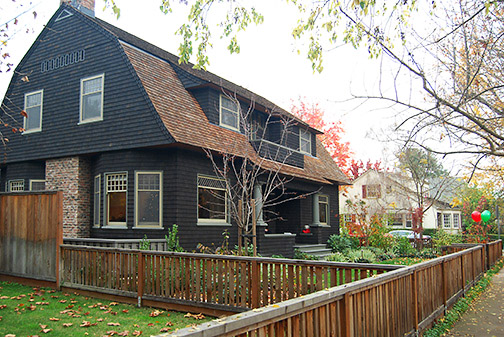 |
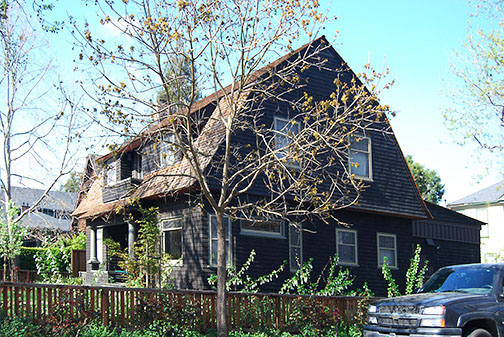 |
| 327 Addison | |
The first houses to sprout from the grain fields surrounding Stanford University became the nucleus of Palo Alto. Merchants and craftsmen favored locations between San Francisquito Creek and University Avenue, near the Southern Pacific railroad depot. Stanford faculty, students and townspeople preferred to settle in the residential area south of downtown, which was easily accessible to the campus.
Two houses typical of the residential area were built on Addison Avenue by Kate Schultze. Kate, a brilliant pianist, had moved from Syracuse, New York to Palo Alto following her husband, Wilhelm’s, death in 1888. Both Schultzes had been professors at Syracuse University; she in piano and vocal music and Wilhelm in theory and practice. Wilhelm had also been the Director of the University’s Music Department. He died while playing a recital. Kate’s first Palo Alto house, at 319 Addison, was built in 1900 and was lived in by her widowed sister, Edith Fallenius, who was a European–trained organist and pianist. When Kate Schultze built her second house at 327 Addison in 1902, she hired H. L. Upham, one of the best known and most proficient of local contractors.
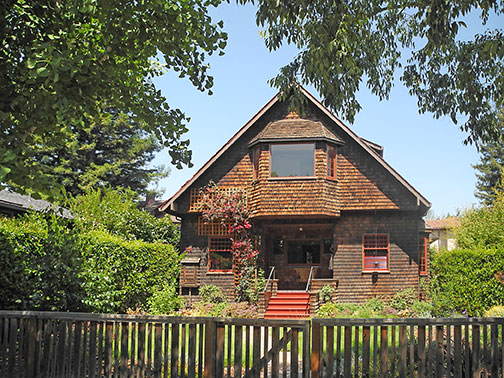 |
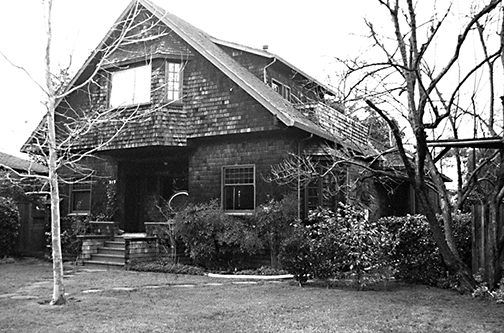 |
| 319 Addison | Palo Alto Historical Association Guy Miller Archive photo |
Upham’s structures, according to Palo Alto’s Planning staff, were not merely notable designs but were also “… more illusionistic and less straightforward” than standard renditions of turn of the century styles. This aptly describes the two story, shingled house which is generally considered a combination of Colonial Revival and Craftsman styles but whose details are an imaginative combination of many architectural elements. The side–gambreled roof with its shed dormers and flared eaves is characteristic of the Dutch Colonial style, a sub-type of the Colonial Revival. This roof became common as a means of increasing the roof span and making use of the attic as livable space. The second story balcony between the double hung dormer windows is an unusual feature seen in the earlier Shingle style. Like the Shingle, it is used here for the effect of a complex shape enclosed within a smooth shingled surface and thus does not interfere with the symmetrical façade. There are variously muntined windows: picture windows with an upper portion of diagonal leaded glass, a bay with 12 to 15 lights over a single pane, simple double hung and two smaller, leaded glass windows flanking the front door.
A wide entry porch is supported by unfluted Tuscan columns with an undecorated frieze above and typical Craftsman shingled bases below. A redwood plank door opens to an interior whose description could come directly from the pages of Gustav Stickley’s magazine, The Craftsman:
A Craftsman house represents not only economy in cost but economy in floor space. The general living rooms are thrown together, usually including the entrance hall and stairway so that the whole lower floor of a Craftsman house has the effect of a great living room. Elaborate ornamentation is eliminated…native woods are used liberally…the fireplace is made an ornamental feature.
Many materials used to build this four bedroom house remain: the fir floors, redwood paneling and doors, leaded glass windows and the fireplace. The ceiling light in the dining room and the light fixture on the newel post on the staircase are original. In the living room, the fireplace was rebuilt with the original blocks.
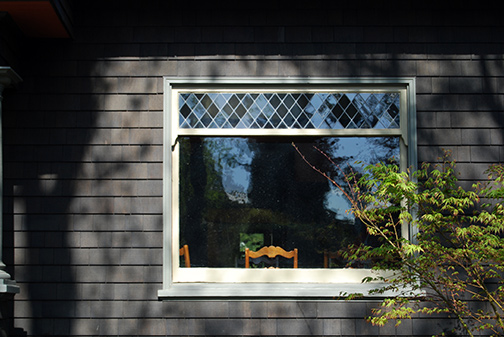
Kate Schultze often supported herself by renting rooms to Stanford professors and affiliates: Harry Haehl, a mining engineer trained at Stanford, Professor J. M. Motley, attorney Clarence H. Crawford, Dr. K.L. Schaupp, and mechanical engineering Professor Horatio W. Stebbins. Stebbins was the son of a well–known Stanford trustee and Unitarian minister of San Francisco. A later occupant was George Varian, who raised his family in this house, just around the corner from the house where his father and uncle, the founders of Varian Associates grew up. Kate’s renown, however, came from the music lessons she offered to generations of Palo Altans and from her active contribution to the advancement of the young town’s musical standards. Old–timers fondly recall the treble clef sign which ornamented her front door. 327 Addison is listed on the City’s Historic Buildings Inventory. In 2010, the current owners received a Residential Preservation Award from Palo Alto Stanford Heritage.©
PAST, May 1, 2015
E-mail us at either webmaster@pastheritage.org or president@pastheritage.org.
![]() Palo Alto Stanford Heritage—Dedicated to the preservation of Palo Alto's historic buildings.
Palo Alto Stanford Heritage—Dedicated to the preservation of Palo Alto's historic buildings.
Copyright © 2015 Palo Alto Stanford Heritage. All rights reserved.